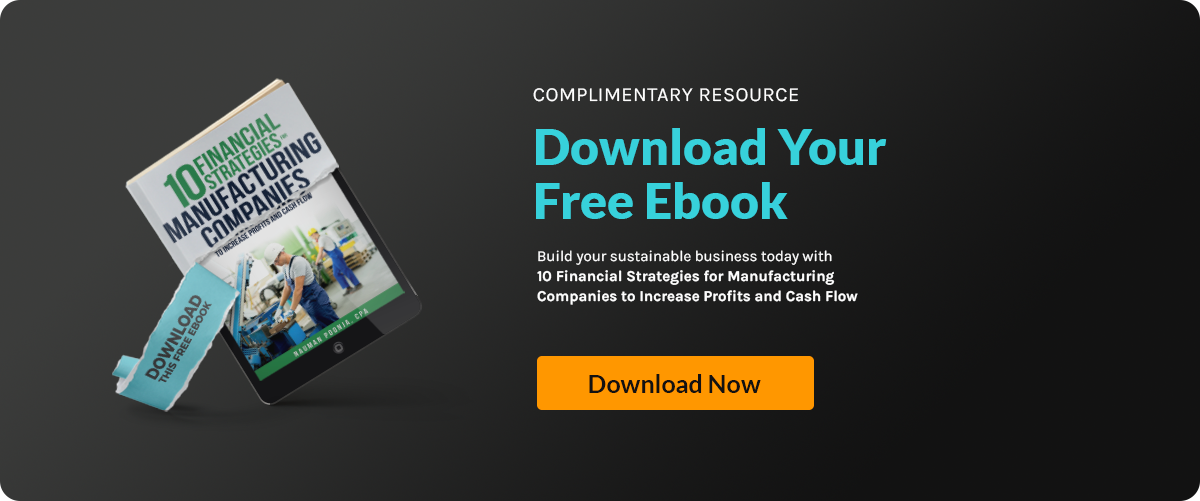Managing inventory goes beyond just tracking products—it directly impacts your cash flow and...
How Opportunity Cost is Shaping Manufacturing Finances

Every decision in manufacturing comes with a trade-off. Invest in new equipment, and you might delay hiring more staff. Focus on one big order; a smaller but steady customer might take their business elsewhere. These trade-offs aren’t just tough calls—they’re opportunity costs.
A study by PwC found that 53% of manufacturing executives make significant decisions at least once a month, with 29% prioritizing new opportunities they can’t ignore. This highlights the importance of understanding opportunity costs in strategic planning. Recognizing what you’re giving up with each choice can help manufacturers spend smarter, allocate resources better, and ultimately strengthen their bottom line.
Read on to see how opportunity cost shapes manufacturing finances—and how you can use it to make smarter, more profitable decisions.
What Opportunity Cost Is and Why It Matters
Opportunity cost is the value of what you forgo when you choose one option over another. It represents the potential benefit missed when picking between different actions. For manufacturers, this could mean deciding whether to invest in new machinery or allocate resources toward launching a new product.
Calculating opportunity cost is a crucial part of cost-benefit analysis—a process manufacturers use to weigh priorities and make informed decisions. Every choice comes with both gains and sacrifices. By clearly understanding what you’re giving up, you can better gauge the true value of each alternative.
For example, let’s say you’re considering a major investment in a new robotic production line. To make the best choice, you need to compare the expected returns from the new equipment to the potential gains from other options, like expanding your workforce or launching a new product line. The difference between the returns on these alternatives is your opportunity cost:
Opportunity Cost = Return on Option Not Chosen – Return on Option Chosen
Having access to up-to-date, accurate financial data makes these evaluations faster and more precise. Real-time insights allow decision-makers to compare options side by side, so choices can be made quickly—and with confidence.
Understanding and applying opportunity cost helps manufacturers prioritize investments, avoid hidden losses, and ultimately make smarter decisions that drive profitability.
Why Calculating Opportunity Cost Can Get Complicated
Figuring out the true opportunity cost isn’t always as clear-cut as comparing apples to apples. Manufacturing leaders often have to weigh a web of options, each with its own ripple effects. For instance, investing in new robotics might boost output—great! But what about the lost chance to diversify your product line, or the long-term savings you forfeit by not upgrading energy systems instead?
Here's why things can get tricky:
- Unpredictable market conditions: What seems like the better option today could lose its shine if raw material prices spike or a competitor enters the scene.
- Hidden impacts: Sometimes, the costs or benefits aren’t immediately obvious—like when employee morale improves after equipment upgrades, quietly boosting productivity.
- Future forecasting: Calculating opportunity cost means making assumptions about the future, and no crystal ball comes with your business license.
In short, while the basic concept is simple, the real-world math can be messy. But tackling these calculations head-on gives manufacturers a sharper edge in every strategic move they make. Understanding opportunity cost helps businesses align decisions with strategic planning, improving financial health and production efficiency.
How Cost-Benefit Analysis Illuminates Opportunity Cost
Cost-benefit analysis acts like a financial compass for manufacturers, especially when the road forks. By systematically weighing gains against losses with each choice, it shines a spotlight on the true value—and potential sacrifice—of every decision.
Here’s how it works in practice:
- Lays Out the Full Picture: Rather than focusing on just what’s gained, cost-benefit analysis prompts decision-makers to consider what’s left on the table.
- Highlights Trade-Offs: Let’s say you’re choosing between expanding your production line or ramping up automation. A thorough cost-benefit exercise helps clarify not just the upfront costs and projected returns, but also the profits, efficiencies, or partnerships you might miss by not pursuing the alternative.
- Informs Prioritization: This level of analysis supports smarter resource allocation, enabling manufacturers to rank opportunities based on both immediate impact and long-term strategic fit.
In essence, cost-benefit analysis doesn’t just assist in crunching numbers—it’s an essential tool for surfacing the hidden opportunity costs behind every pivotal manufacturing decision.
How Capitalized Expense and Cash Flow Impact Choices
Capitalized expenses are investments in long-term assets that provide value over several years. Cash flows refer to money coming in and going out of the business. Capitalized expense and cash flows form the foundation of any strategic investment decision.
Let’s explore how managing capitalized expenses and cash flows causes different outcomes and impacts business decision-making. Live, accurate financial data is essential when calculating opportunity cost. Without up-to-date numbers, it’s impossible to get a clear picture of what each decision truly costs—or what you might be giving up. Real-time financial information allows manufacturers to see exactly where their resources are tied up, how much cash is available, and how investments are performing.
For example, using cloud-based financial systems like NetSuite or QuickBooks Online, teams can instantly pull the latest reports instead of relying on outdated spreadsheets. This gives decision-makers the clarity and speed required to weigh their options quickly, avoid missed opportunities, and respond with agility as market conditions shift. In short, accurate data isn’t just bookkeeping—it’s the foundation for smart, confident manufacturing decisions.
Cause: Managing Capitalized Expense and Cash Flows
Capitalized expenses and cash flows affect how well a company uses its resources. For example, purchasing new machinery as a capitalized expense can increase production efficiency over time. However, if cash flows are limited, this may mean delaying other essential upgrades or operations. Cash flows often lead to constrained choices, which could prevent the business from missing out on the opportunity cost of choosing a better alternative.
Effect: Impact on Decision-Making
When capitalized expenses are appropriately managed, and cash flows remain stable, companies can make strategic decisions that align with their goals. Positive cash flows allow the company to invest in new technology that boosts production efficiency. By doing so, manufacturers maximize opportunity benefits without compromising day-to-day needs.
On the other hand, insufficient cash flows can restrict decision-making, reduce potential opportunity cost benefits, and impact long-term growth. Opportunity cost is always present, but strong management of capitalized expenses and cash flows can help mitigate the risks.
How Technology Streamlines Opportunity Cost Calculations
Modern manufacturing moves fast, and decision-makers need reliable numbers at their fingertips. That’s where cloud-based financial platforms like NetSuite come in. These systems pull together real-time financial and operational data, making it easier to see both the costs and the potential returns of every big decision.
With accurate, up-to-date insights, you can quickly compare the pros and cons of each opportunity—whether it's investing in new equipment, launching a product line, or expanding operations. This speed and clarity empower leaders to gauge the opportunity cost of one choice versus another far more efficiently than with manual spreadsheets or siloed systems.
In short: Leveraging cloud technology ensures manufacturers don’t just make decisions—they make informed, strategic ones with a clear understanding of what’s gained and what’s left on the table.
Balancing Production Efficiency with Opportunity Costs
How capitalized expenses and cash flows are managed can significantly impact production decisions. It’s time to explore how production efficiency interacts with opportunity cost. Finding a balance between improving efficiency and managing other resources can be challenging.
Let’s look at the pros and cons to see the trade-offs manufacturers face.
|
Pros of Focusing on Production Efficiency |
Opportunity Costs Involved |
|
Increases output without needing extra resources |
Opportunity cost is missing out on other potential investments |
|
Reduces waste, leading to higher productivity |
Limited resources may prevent funding other growth initiatives |
|
Improves operational consistency and reliability |
Opportunity cost is the potential returns from pursuing a different course of action |
Key Considerations
When manufacturers focus on production efficiency, they improve productivity and stability. However, opportunity cost is always a factor—whether it's resources that could have been spent on new technology or missed potential gains from pursuing a different strategy. Understanding these trade-offs helps ensure informed business decisions that balance production efficiency and long-term growth.
Maximizing Return on Total Investment Through Smart Decisions
Balancing production efficiency with opportunity costs is crucial to making wise decisions. However, manufacturers must take deliberate actions to maximize the return on investment. Let’s explore practical steps that help turn smart decisions into more significant returns.
Step 1 - Identify and Evaluate Opportunity Cost
Start by understanding what you give up when making a choice. Analyzing the opportunity cost will help select the action with the highest potential return on investment.
Step 2 - Focus on High-Impact Areas
Target areas that contribute most to growth. Examine production efficiency and invest in tools or processes that increase output without significant expenses. This will effectively boost the return on total investment.
Step 3 - Revisit Sunk Costs
Identify sunk costs that are no longer serving the business. Removing these will free up resources that could be used for investments, offering a better return on total investment. Avoiding unnecessary spending is critical to improving overall efficiency.
Step 4 - Set Clear Performance Metrics
Define clear metrics to track the impact of each investment. Use these metrics to compare expected returns versus actual results. Regular tracking ensures that every move is aligned with improving return on total investment.
Step 5 - Leverage Production Efficiency
Invest in tools or systems that directly enhance production efficiency. Greater efficiency often translates into reduced waste and increased profit, driving up return on total investment. Maximizing efficiency minimizes losses and supports long-term growth.
Step 6 - Regularly Reassess Investments
Keep reevaluating existing investments. Circumstances change, and a once beneficial investment might need adjusting. Consistent reassessment ensures every dollar contributes to the maximum return on total investment.
Turn Trade-Offs into Triumphs with Accounovation—Contact Us Today!
In manufacturing, opportunity cost is always part of the equation. Every choice, from equipment investments to production schedules, involves trade-offs. We understand how difficult it can be to weigh these decisions while keeping your finances on track and your goals in sight.
At Accounovation, we help manufacturers like you analyze costs, maximize resources, and make informed financial decisions. With services like pricing analysis, forecasting, and cash flow planning, we’ll help you turn opportunities into results. Let’s discuss how we can support your success—reach out today!
Frequently Asked Questions
How can balancing trade-offs lead to better financial outcomes in manufacturing?
Balancing trade-offs allows manufacturers to allocate resources more effectively, ensuring immediate needs are met without compromising future growth. This approach helps optimize investments and minimize risks.
How can manufacturers assess the impact of missed opportunities on their financial health?
Manufacturers can evaluate missed opportunities by analyzing financial data, comparing projected returns against realized outcomes, and using performance metrics to understand the cost of alternative decisions.
How does managing expenses and cash inflow influence business decisions?
Effective expense and cash inflow management ensures that companies maintain operational stability, enabling informed investments and reducing the risk of financial strain during critical decision-making periods.
How can manufacturers identify and eliminate costs that no longer add value?
Manufacturers can pinpoint and remove unnecessary expenses by conducting regular financial reviews, assessing the performance of existing investments, and comparing costs against their contribution to overall goals.
How can manufacturing companies ensure their decisions support immediate needs and long-term stability?
Companies can align short-term actions with strategic goals by forecasting, setting clear priorities, and maintaining flexibility to adapt to changing circumstances. This ensures balanced progress toward sustainability and growth.







